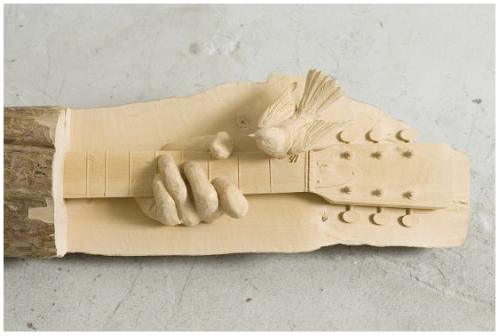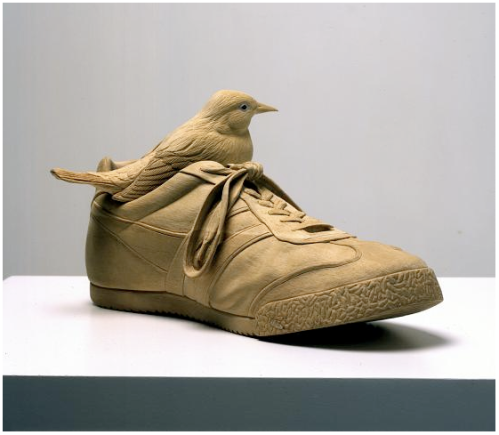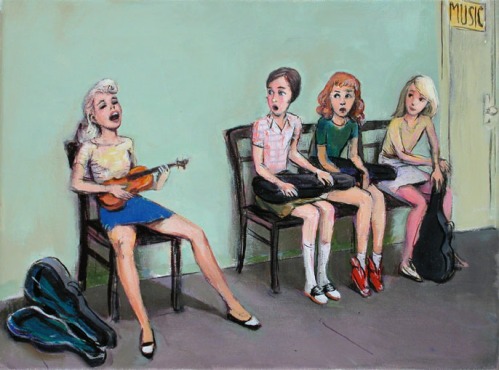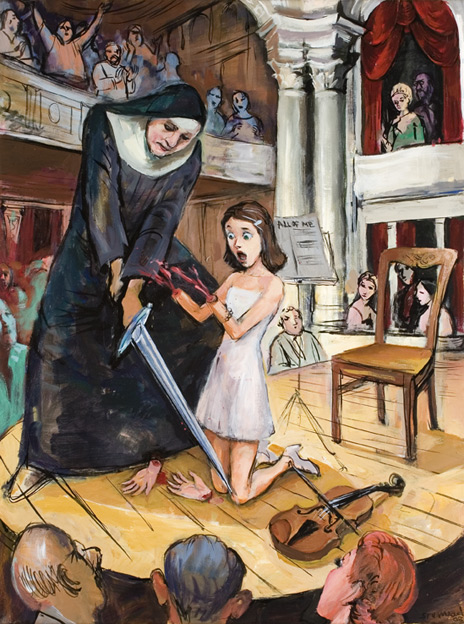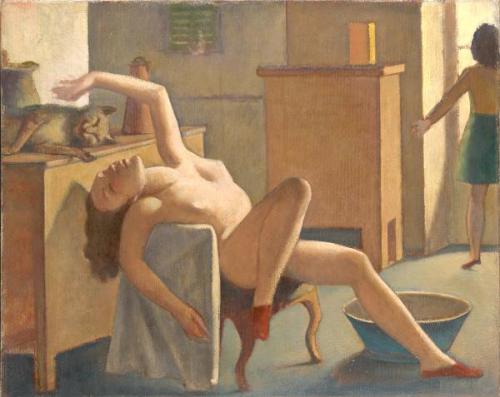
Balthus
French 1908 – 2001
worked in Italy 1961 – 1977
Nude with cat
Nu au chat
1949
oil on canvas
Balthus was a self-taught, figurative painter, who made a significant contribution to 20th century european art. Whilst not falling clearly into a particular artistic movement, early in his career Balthus mixed with individuals such as Andre Breton and others involved in the surrealist art movement. In ‘Nude with cat’ 1949, the painter continues with his often repeated themes; highly eroticized depictions of pubescent young women, designed to lure the viewer into feelings of lust and desire. This essay intends to demonstrate the ways in which Balthus uses his subject matter, and technical ability, to enforce these feelings onto the viewer and at the same time, cause the viewer to feel a sense of uncertainty due to the ambiguous and moral dilemmas offered by the painting.
In Nude with cat, a young woman is depicted during her morning wash, leaning back on a chair whilst the light thrown in through the open window illuminates her nude body, it is clear that she is the primary subject of the picture. The viewers first reaction to her awkward backwards leaning pose, closed eyes and thrown back head is to associate it with erotic ecstasy. However, upon closer examination the true meaning of this stance is unclear. Is the girl leaning backwards to pet the cat or is she merely stretching? It would not be unusual for a young girl, early in the morning, to do either of these things. Balthus plays with the ambiguity of the situation causing the viewer to over-compensate(1) and reach the logical, erotic, conclusion.
In the corner of the room, a figure opens the curtains and allows daylight to fall onto the subject. The use of chiaroscuro emphasizes the fall of light onto the naked body and it is no coincidence that the model’s breast is captured by the full strength of the light entering the room. The open window is both a functional device, to allow these lighting characteristics to exist, but also acts as a visual metaphor, literally throwing light onto the subject (2). Again, Balthus uses this feature of the painting to emphasise the erotic nature of the subject, while also using the character at the window as a background counter-balance to the cat and nude in the foreground. In taking up the majority of the space on the canvas, it is clear that the nude should be the primary occupation of the viewer’s mind.
Weber’s argument that the cat is a representation of the painter(3), does not go far enough in it’s analysis. Weber acknowledges the cat as an observer, an all-seeing figure that watches without disclosing it’s own agenda, but fails to mention that in this image, the cat bears an almost childlike grin, happy to be given the attention of the beautiful subject. If the cat does represent the painter, then the feelings of the cat echo the viewer’s erotic desire, if not to possess, then to be, at least momentarily, possessed by the girl. Claire offers an extension of this idea in arguing that the outstretched reach of the girl’s arm towards the cat, signifies the association of her “voluptous dream” with the animal (4). This argument enforces the sexuality of the child, which the viewer tries to deny. It is exactly this feeling of uncertainty that Balthus wants to capitalise on. By depicting the subject as a sexual object, whether intentionally on the subject’s part or not, the viewer is almost forced to associate their own sexual desires with the subject. However, by using the girl, who represents innocence and naievity, Balthus causes the viewer to also associates feelings of moral obligation and protection with the subject and it is this unresolved tension that gives the painting it’s power.
Whilst there are no obviously visible brushstrokes, there is a sense of urgency to the way the oil has been applied to the canvas. Balthus seems to place particular and deliberate emphasis on the subject’s features; figurative representation is the goal rather than any attempt at realism. The physical characteristics of the girl and the cat also emphasise this point; her neck seems to be exposed at an impossible angle, as is her shoulder reaching behind and over her head. The exposed neck also suggests the vulnerability of the subject, again confusing the viewer with respect to their own feelings and conflicting desires towards the subject matter.
There is also a sense of contrast and geometry in the composition. The woman’s curves are in opposition to the stark lines of the sparsely decorated room. An extension of the differences between the girl and the society she inhabits, this highlights the difference between attitudes and reminds the viewer that the tamed, controlled and civilized think in ‘straight lines’, while the free, naieve and innocent are not bound by the constraints of civilized society.
Balthus uses a number of techniques to re-inforce the sexual nature of both the subject, and the viewer’s reactions to it. The meaning of the painting is primarily to remind us of our sexual nature as human beings. In doing so, Balthus brings the viewer to the edge of what is deemed morally and socially acceptable. Any feelings experienced however, are the viewers own, and taboos are broken in the mind of the viewer and not by the brush of the artist. Balthus reminds us that to deny our sexual urge, is ultimately to deny our own human nature.
—————-
1. Weber 1999, pp. 61-63
2. Weber 1999, pp. 128
3. Weber 1999, pp. 478-479
4. Clair 2001, pp. 302
———————-
bibliography
Claire 2001: Jean Clair, Balthus, London: Thames & Hudson, 2001.
Weber 1999: Nicholas Fox Weber, Balthus: A Biography, London: Weidenfeld & Nicolson, 1999.
